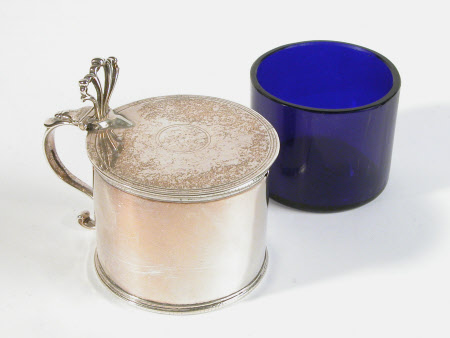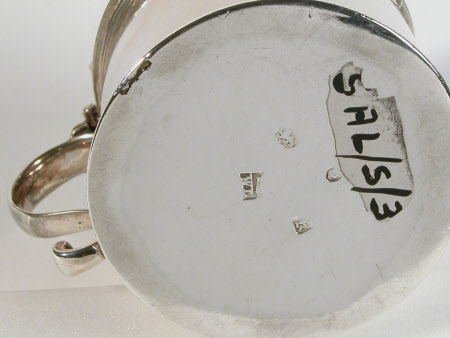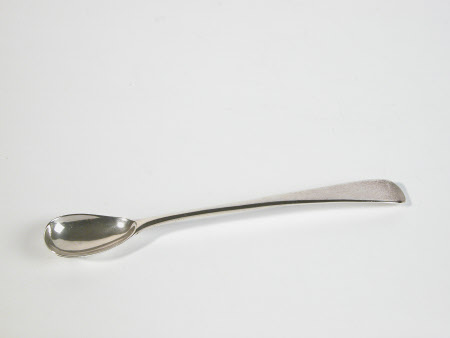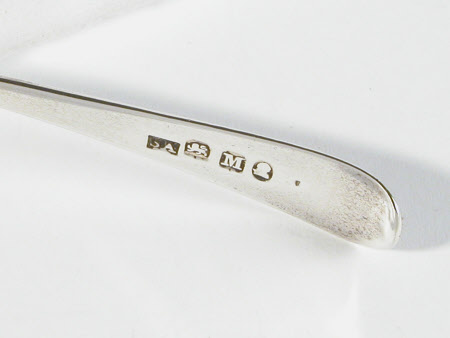Mustard pot
probably William Lestourgeon
Category
Silver
Date
1765 - 1766
Materials
Sterling silver and Glass
Measurements
50 mm (Height)
Place of origin
London
Order this imageCollection
Saltram, Devon
NT 872309
Summary
Mustard pot, sterling silver, probably by William Lestourgeon, London, 1765/6. With blue glass liner and associated mustard spoon, sterling silver, by Stephen Adams II, London, 1807/8. The circular, straight-sided pot is made of seamed sheet silver with an S-scroll handle and tripartite scroll-and-pellet thumb-piece. The three-part hinge connects the handle to the circular cover which has reeding to the edge and a central reeded circle. There are stepped and milled foot and lip rims. The blue glass liner is plain and conforms to the pot. The spoon has an oval bowl joined at the point to the tapering, plain stem with down-turned terminal unadorned with initials or armorials. Heraldry: Engraved within the central circle on the cover of the pot is the Parker crest (very rubbed), probably for Montagu Edmund Parker (1737-1813). Hallmarks: POT: Fully marked on the underside with leopard’s head crowned, sterling lion, date letter ‘K’ for 1765/6 and maker’s mark WL beneath a fish probably for William Lestourgeon (Arthur Grimwade, London Goldsmiths, 1990, no. 3893). SPOON: Fully marked on the reverse with maker’s mark SA for Stephen Adams II (Arthur Grimwade, London Goldsmiths, 1990, no. 2473), sterling lion, date letter ‘M’ for 1807/8, and monarch’s head facing right.
Full description
Mustard in the early 18th century was often served dry and contained in a blind or sheathed caster, as part of a set of three with pierced casters for sugar and pepper (for more information on this see NT 852084). As the century progressed, however, it was increasingly pre-mixed and pots for wet mustard were made in ever larger numbers. By the middle of the century the form of a miniature straight-sided tankard, or drum, predominated, as in this pot which is an early example. Piercing to the sides had not yet become a standard feature but was being used by Lestourgeon, as seen on a mustard pot of 1764/5 with York Minster Antiques in 2025. Arthur Grimwade, in the second edition of London Goldsmiths 1697-1837 (1990) attributed the maker’s mark of WM beneath a fish, found on this pot, to William Lestourgeon because of the play on his name and the fact that he is recorded in the retailer, Parker and Wakelin’s Workers’ Ledger No. 2 (National Art Library) as being a supplier with his son Aaron of mustard pots and other small items. The account begins in 1766 and is brought forward from a previous, lost ledger. Parker and Wakelin were patronised by the 1st Lord Boringdon but not, it seems, by his brother Montagu Edmund Parker (1737-1813) of Whiteway House, Devon, who is the likely first owner of this mustard pot. It is not engraved with a baron’s coronet as are most of the pieces commissioned by Lord Boringdon and of the five pots recorded in the Whiteway and Saltram plate lists, of 1880 and 1886 respectively, only that found amongst the silver allocated from Whiteway for the use of Lady Katherine Parker (1846-1910) could relate to this piece. Lady Katherine’s mother, Harriet Parker, Countess of Morley (1809-97) was then the owner and occupier of Whiteway in succession to her brother, the last Montagu Edmund Parker (1807-58). James Rothwell, National Curator July, 2025
Provenance
Montagu Edmund Parker (1737-1813); by descent to Harriet Sophia Parker, Countess of Morley (1809-97); Lady Katherine Parker (1846-1910); Edmund Parker , 4th Earl of Morley (1877-1951); Montagu Brownlow Parker, 5th Earl of Morley (1878-1962); National Trust.
Credit line
Saltram, the Morley Collection (National Trust)
Makers and roles
probably William Lestourgeon, goldsmith Stephen Adams (d.1840), goldsmith



